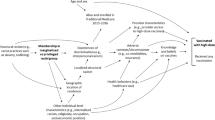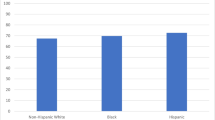Abstract
BACKGROUND: Despite known benefits of influenza vaccination and coverage by Medicare Part B, elderly minority patients are less likely to receive influenza vaccination than whites.
OBJECTIVES: To test whether a nonphysician-initiated standardized offer of influenza vaccination to all elderly primary care patients would result in similar proportions of African-American and white patients accepting vaccine.
DESIGN: In 7 metropolitan Detroit primary care practices during the 2003 influenza vaccination season, medical assistants assessed influenza immunization status of all patients 65 years and older and collected limited demographic data. Eligible patients were offered vaccination.
MEASUREMENTS: Proportion of patients accepting influenza vaccination by race and predictors of vaccine acceptance.
RESULTS: Four hundred and fifty-four eligible patients with complete racial information were enrolled: 40% African American, 52% white, 8% other race/ethnicity. Similar proportions of African Americans and whites had already received the 2003 vaccine (11.6% and 11.0%, respectively) or stated vaccination as the reason for visit (23.8% and 30.5%, respectively). Among the remainder, there also were similar proportions who accepted vaccination: 68.9% white and 62.1% African-American patients. History of previous vaccination was the only statistically significant predictor of vaccine acceptance (odds ratio [OR] 8.64, 95% confidence interval [CI] 4.17, 17.91, P<.001). After adjusting for history of previous vaccination, age, gender, and education, the odds of vaccine acceptance were no different for whites and African Americans (OR 1.20, 95% CI 0.63, 2.29, P=.57).
CONCLUSIONS: Vaccination acceptance differed little between African-American and white elderly patients. Using nonphysician personnel to identify and offer influenza vaccine to eligible patients is easily accomplished in primary care offices and has the potential to eliminate racial disparities in influenza vaccination.
Similar content being viewed by others
References
Voordouw ACG, Sturkenboom M, Dieleman JP, et al. Annual revaccination against influenza and mortality risk in community-dwelling elderly persons. JAMA. 2004;292:2089–95.
Nichol KL, Nordin J, Mullooly J, Lask R, Fillbrandt K, Iwane M. Influenza vaccination and reduction in hospitalizations for cardiac disease and stroke among the elderly. N Engl J Med. 2003;348:1322–32.
Nordin J, Mullooly J, Poblete S, et al. Influenza vaccine effectiveness in preventing hospitalizations and deaths in persons 65 years and older in Minnesota, New York, and Oregon: data from 3 health plans. J Infect Dis 2001;184:665–70.
Prevention and Control of Influenza. Recommendations of the Advisory Committee on Immunization Practices. Centers for Disease Control and Prevention. MMWR 53; 1–40, 2004. Available at: http://www.cdc.gov/mmwr/preview/mmwrhtml/rr5306a1.htm. Accessed December 16, 2005.
Medicare. Preventive services/ Flu information. Important information about Medicare payment for flu shots. Available at: http://www.medicare.gov/Health/flu.asp. Accessed December 16, 2005.
Centers for Disease Control and Prevention. Early release of selected estimates based on data from the 2003 National Health Interview Survey. Available at: www.cdc.gov/nchs/data/nhis/earlyrelease/200406_04.pdf. Accessed December 15, 2005.
Healthy People 2010. 2nd edn. Washington, DC: U.S. Government Printing Office; 2000.
Marin M, Johanson W, Jr, Salas-Lopez D. Influenza vaccination among minority populations in the United States. Prev Med. 2002;34:235–41.
Centers for Disease Control and Prevention. Behavioral risk factor surveillance system prevalence data. Available at: http://apps.nccd.cdc.gov/brfss. Accessed December 16, 2005.
Armstrong K, Berlin M, Schwartz JS, Propert K, Ubel PA. Barriers to influenza immunization in a low-income urban population. Am J Prev Med. 2001;20:21–5.
Bovier PA, Chamot E, Bouvier Gallacchi M, Loutan L. Importance of patients’ perceptions and general practitioners’ recommendations in understanding missed opportunities for immunizations in Swiss adults. Vaccine. 2001;19:4760–7.
Chapman GB, Coups EJ. Predictors of influenza vaccine acceptance among healthy adults. Prev Med. 1999;29:249–62.
Nowalk M, Zimmerman RK, Shen S, Jewell I, Hyg M, Raymund M. Barriers to pneumococcal and influenza vaccination in older community-dwelling adults (2000–2001). J Am Geriatr Soc. 2004;52:25–30.
Ru-Chien C, Neuzil K. The association of sociodemographic factors and patient attitudes on influenza vaccination rates in older persons. Am J Med Sci. 2004;327:113–7.
Telford R, Rogers A. What influences elderly peoples’ decisions about wheter to accept the influenza vaccination? A qualitative study. Health Educ Res. 2003;18:743–53.
Egede LE, Zheng D. Racial/Ethnic differences in adult vaccination among individuals with diabetes. Am J Public Health. 2003;93:324–9.
Fiscella K, Franks P, Doescher MP, Saver BG. Disparities in health care by race, ethnicity, and language among the insured: findings from a national sample. Med Care. 2002;40:52–9.
Ostbye T, Taylor D, Lee A, Greenberg G, van Scoyoc L. Racial differences in influenza vaccination among older Americans 1996–2000: longitudinal analysis of the Health and Retirement Study (HRS) and the Asset and Health Dynamics Among the Oldest (AHEAD) survey. BMC Public Health. 2003;3:41.
Rangel M, Shoenbach V, Weigle K, Hogan V, Strauss R, Bangdiwala S. Racial and ethnic disparities in influenza vaccination among elderly adults. J Gen Intern Med. 2005;20:426–31.
Zimmerman RK, Santibanez TA, Janosky JE, et al. What affects influenza vaccination rates among older patients? An analysis from innercity, suburban, rural, and Veterans Affairs practices. Am J Med. 2003;114:31–8.
Goebel L, Neitch S, Mufson M. Standing orders in an ambulatory setting increases influenza vaccine usage in older people. J Am Geriatr Soc. 2005;53:1008–10.
Rhew D, Glassman P, Goetz M. Improving pneumococcal vaccine rates: nurse protocols versus clinical reminders. J Gen Intern Med. 1999;14:351–6.
Associated Press. Flu season starting early and strong. Available at: http://msnbc.msn.com/Default.aspx?id=3475851&p1=0. Accessed December 16, 2005.
Task Force on Community Preventive Services. Recommendation regarding interventions to improve vaccination coverage in children, adolescents, and adults. Am J Prev Med. 2000;18:92–6.
Schneider EC, Cleary PD, Zaslavsky AM, Epstein AM. Racial disparity in influenza vaccination: does managed care narrow the gap between African Americans and whites? JAMA. 2001;286:1455–60.
Hebert P, Frick K, Kane R, McBean M. The causes of racial and ethnic differences in influenza vaccination rates among elderly Medicare beneficiaries. Health Serv Res. 2005;40:517–37.
Fiebach NH, Viscoli CM. Patient acceptance of influenza vaccination. Am J Med. 1991;91:393–400.
Nichol KL, Mac Donald R, Hauge M. Factors associated with influenza and pneumococcal vaccination behavior among high-risk adults. J Gen Intern Med. Nov. 1996;11:673–7.
Centers for Disease Control and Prevention. Early release of selected estimates based on data from the 2004 National Health Interview Survey. CDC. Accessed August 22, 2005.
Smedley BD, Stith AJ, Nelson AR. Unequal Treatment: Confronting Racial and Ethnic Disparities in Health Care. Washington, DC: National Academy Press; 2003.
Stone E, Morton S, Hulscher M, et al. Interventions that increase use of adult immunization and cancer screening services: a meta-analysis. Ann Intern Med. 2002;136:641–51.
Author information
Authors and Affiliations
Corresponding author
Additional information
The findings and conclusions in this report are those of the authors and do not necessarily represent the views of the funding agency.
Funded in part by AAMC/CDC cooperative grant U36/CCU319276 CFDA 93.283.
Rights and permissions
About this article
Cite this article
Schwartz, K.L., Neale, A.V., Northrup, J. et al. Racial similarities in response to standardized offer of influenza vaccination. J Gen Intern Med 21, 346–351 (2006). https://doi.org/10.1111/j.1525-1497.2006.00401.x
Received:
Revised:
Accepted:
Issue Date:
DOI: https://doi.org/10.1111/j.1525-1497.2006.00401.x




